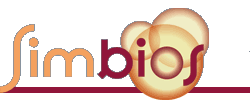|
|
$10.6 million grant awarded to advance the use of simulations in drug discovery and neuroprosthetics
BY JOY P. KU Simulations touch our lives in countless ways, from training the pilots who fly us across the country to making the computer chip in our laptops run faster. Its role in biology and medicine just got a boost from the National Institutes of Health (NIH). They have awarded $10.6 million to Russ Altman, professor and chair of bioengineering, Scott Delp, professor of bioengineering, and Vijay Pande, associate professor of chemistry, to fund the National Center for Physics-Based Simulation of Biological Structures (Simbios) for the next four years. "Simbios is entering a very exciting period," says Altman. "With the core software we've developed, we're now able to use simulations to investigate problems we couldn't previously study and we'll keep pushing those boundaries." Simbios is one of six national centers currently funded by the NIH to help establish a biomedical computing infrastructure and accelerate research breakthroughs. These national centers for biomedical computing (NCBCs) are resources for the entire biomedical community. Simbios' mission is to engage and enable individuals to use physics-based simulations to model and understand biological systems. Driving Research in Drug Discovery and Neuroprosthetics Each center tackles a few select driving biological problems (DBPs). This ensures that the tools and methods they develop will have a biological or clinical impact. At Simbios, the focus will be on using physical simulations to better understand how drugs work and to investigate how brain activity controls movement within natural settings. That's particularly good news for the pharmaceutical industry and for the neuroscience community. Neuroscience is just starting to understand the brain-movement relationship in more natural settings. "But what's completely missing is the biomechanical model - how is the neural activity driving the muscles, which drive the bones that generate the movement," says Krishna Shenoy, associate professor of electrical engineering, an NIH Pioneer Award winner, and co-leader of the neuroprosthetics DBP with Delp. "If you can successfully map neural activities to a realistic muscle model, then you've effectively also solved the neuroprosthetics problem. And that's one of the reasons Simbios is really important." Brian Shoichet, professor of pharmaceutical chemistry at U.C. San Francisco and an expert in developing drug docking software, heads Simbios' drug targeting DBP. The collaboration will investigate how simulations can improve predictions of drug interactions with B2AR, a common target protein. Simbios' fast simulation and analysis methods make it possible to now model and study the dynamic behavior of a large protein like B2AR. Accelerating Biosimulation Software Development for High-Performance Computers Simbios will also be leading efforts to bring the high-performance capabilities of next-generation computers to the biomedical community. It has teamed up with Stanford's Pervasive Parallelism Lab (PPL) to define Domain Specific Languages (DSLs) that programmers can use to rapidly and easily write simulation code to run efficiently on many different hardware platforms. "Every scientist and biologist will be using parallel computing in the future," says Pat Hanrahan, professor of computer science and an active PPL member. "It's everywhere - even in your cell phones - but it's complex. Domain specific languages will hide the complexity while still allowing people access to the power of the underlying hardware." Training Next-Generation Scientists Simbios is about more than just molecules, bits, and bytes. It's about people. Simbios is committed to training individuals to work at the intersection of biology and computations. Through its Distinguished Postdoctoral Fellows program, software training workshops, and a new software engineering internship program for San Francisco State University computer science students, the center will help build the intellectual capacity to advance biomedical simulations and research. Building on Past Successes Established in 2004, Simbios has already had an impact on biomedical research. In addition to training hundreds of people to use simulation tools, Simbios has created a robust simulation toolkit, SimTK, that enables dynamic modeling of biological structures of all sizes. Its OpenSim application for simulating movement has enabled dozens of hospitals to improve treatment planning for children with movement disorders, and the OpenMM software library it developed can be used to accelerate calculations on graphics processing units (GPUs) for AMBER and GROMACS, two of the most popular molecular dynamic simulation package currently available. Simbios has also developed a website (Simtk.org) for researchers to collaborate and share biomedical software and data. "In addition to the outstanding science that has come from Simbios, we've been impressed with the growth of their Simtk.org software repository - it currently serves more than 12,000 members, with hundreds more joining each month," says Peter Lyster, program director in the Center for Bioinformatics and Computational Biology at the NIH and Simbios' program officer. "The repository has become an important virtual gathering place for developers and users of biomedical simulation software." "We've accomplished some great things in the last six years and are well-positioned to accomplish even greater things in the next four," says Altman. Simbios is supported by the National Institutes of Health through the NIH Roadmap for Medical Research Grant U54 GM072970. It is one of six National Centers for Biomedical Computing. More information about the National Centers for Biomedical Computing can be obtained from http://ncbcs.org. To learn more about Simbios and its research and software tools, visit http://simbios.stanford.edu.
| |




